
Mal & Tracy
visit Barcelona.
Saturday 31/10/1998.
Another travelogue by Malcolm Weller.
Mal & Tracy visit Barcelona. Saturday 31/10/1998. Another travelogue by Malcolm Weller. |
From the Gaudi architecture to the tasty Tapas, Barcelona has been described by many as their favourite city in Europe.
Exchange rate: £1=227 pesetas.
The plane took an odd route that seemed to be giving us a guided tour over the hills just inland, a stretch of coast, a quick trip out to sea and finally down to land just south of the city. Despite it being a popular tourist destination, the airport was very quiet and we easily found the train (700pts for 2) into the city. After a take out cappuccino (300pts for 2) sitting by the fountains at Rambla de Canaletes we strolled the sort distance down the Rambla to our hotel (Hotel Lloret, 7800/night inc. tax) for the next 4 nights. Our room turned out to be quite small but clean and well presented. We had a balcony just large enough or the two of us to squeeze onto (shared with the aircon unit) that looked out onto the tree lined (lime trees I think) Ramblas, apparently the best known street in Barcelona and perhaps even all Spain. It would be fun being so close to all the activity until we wanted to sleep. |
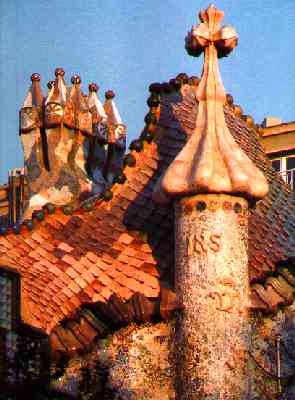 Back out into the tee-shirt weather of the afternoon, we made for the Catalunya Oficiana Turisme which turned out to have moved. On the way to it's new location in Passeig de Gracia we passed the most curious building which seemed to depict a dragon on it's rooftop with a stone cross in the forefront representing Sant Jordi (Saint George). This transpired to be one of Antoi Gaudi's famous gaudy buildings (Cassa Batllo) squezed between two buildings of more standard architecture. I'm sure Gaudi got his inspiration from the story of Hansel and Gretel because the roof seemed kind of edible (despite it's dragon shape). The motor traffic pleasantly light and, or perhaps because it is restricted to narrow channels around the paved areas. An abundance of trees probably shade the streets in high summer but now just nicely break up the view of the buildings. Most of the architecture in the centre of town is the same as London's but with interesting variations, the most famous being Gaudi's. There are other interesting buildings around even some recent ones. Statues and other structures seem to abound on every street. |
The evening took us as far as a pasta cafe next door to our hotel then the next block to an atmospheric bar in an 'old world' sort of way. At the back of the room was a small meridian level holding a piano but after a couple of beers (215pts each) the pianist had not turned up so we went for a stroll down the Ramblas to the waterfront where the Maremagnum centre seemed to be keeping the night-life alive with it's bars, restaurants and nightclubs. The Ramblas was just as lively and noisy outside our bedroom window when we went to sleep at 2am. |
1/11/98. Bus Turistic.
Whenever we visit a new city we often find it useful to take a ride on the tourist bus. This way we can see all the interesting places around the city and where they are relative to each other. The guide often provides useful background information on each place helping us decide where would be best to take a longer visit. This bus ride (1700pta each) gave us a nice view of the city and allowed us to gain our bearings but the commentary, although in 3 languages (Spanish, English and French) gave very little information other than the name, location and whether your bus ticket gave a discount or not. Steeping out of our hotel right onto the Ramblas makes finding a place to eat dead simple. We can't walk far before being tempted into a Tapas bar (La Xerinola). The waiter was very helpful and showed us around all the tempting dishes on display at the counter. We chose octopus, cuttlefish, Russian salad and artichoke in batter all washed down with lots of Sangria which turned out to provide an excellently meal. Another couple of Estrella's at bar Viena (still no pianist) before bed. |
2/11/98. Tracy's birthday.
|
Down at the waterfront we checked out the Imax cinema but decided that the full impact would be lost on us as they wee only in Spanish. As we walked on around the harbor we spotted the Greenpeace Rainbow Warrior taking a break between saving whales. Our destination was a rather old looking steel tower that formed one end of a cable car ride starting from the beach, going via another tower in the harbour and then half way up Montjuic. From there it was a steep walk to Castell de Montjuic, which was more of a fortress than a castle. Montjuic is a separate piece of headland that seems a little out of place on the coast surrounded by the relatively flat land that Barcelona is built on. This of course made it a great place to build a castle and now makes for a good place to view the city. The 1992 Olympics were also staged on this hill. |
 The Funicular Aereo took us back down to the beach providing us with another aerial view of the city. My guess is that it was constructed for the Barcelonas 1929 World Exhebition as it seems to be useful for scenic purposes rather than transport. The beach front is very well kept and is floodlight nicely as it gets dark. The old fisherman’s village seems to have become tenaments for poor folk so we walk along the beach to the Olympic village which turns out to be two tower blocks and some commercial restaurants. It is all shiny and new but strangely un-populated. |
3/11/98. Churches.
After a brief visit to Esglesia de Santa Maria del Pi (a church) we worked our way down the quiet back streets to the cathedral and it's cloister which turned out to be the best bit. Here there was a sectioned off central square where a flock of geese seemed to take permanent residence amongst the little fountains, trees and statues. We popped our heads into the main cathedral where a bit of singing was going on but soon got bored of this and wandered out to the sunshine. Something special must have been going on because there was a band warming up and a film crew ponsing about. A few minutes later the cathedral doors opened and a couple of thousand people poured out into the square. The band began to play, groups started to dance and the film crew were thankfully lost in it all. What it was all about we still don't know but it was fun just being there. |
Via some more atmospheric back streets we arrive at the Arc de Triomf (pretty much like any other Arc, just in Barcelona) and make our way to the Parc de la Ciutadella, a nice quiet place featuring a disproportionaly large multi-level fountain with stairs and statues of horses and everything. An evening meal of nachos in a commercial restaurant with an unusually intoxicating pitcher of margarita precedes a bottle of wine in our room. |
4/11/98. More churches.
First thing we went to a little square we had spotted the previous day and breakfasted on fruit, yogurt and croissants bought from a nearby little supermarket. Having spent a few days there we are beginning to find alternatives to the patisseries and coffee bars. At least half of the shops in this area are eateries. Our first destination today is Sagrada Familia, another of Gaudi's creations. On the way we stumble upon a little square walled garden with a covered walkway around the edge very similar to the one at the cathedral yesterday but without the geese. This turns out to be the cloister to Esglesia de Santa Maria del Pi (church) that we also visited yesterday. One of the windows from looked into an interesting looking living room, presumably used by some priest or other. |
After a long walk along wide noisy streets without much of architectural interest we arrive at the Sagrada Familia. Since it was started in 1882 it has not yet been halfway completed although allot appears to have been built recently. There are now 8 of the 17 outer towers standing, each around 100m tall. Down below there is a good museum of pictures, models and plans of construction. Much to our amazement we find that a little door in the base of a tower leads up to a maze of passages around and through four of the towers so we spend the best part of an hour weaving between the towers and making for the top. It is now that you realise why these places are off limits to the general public for many of the walls on the lower sections are covered in scratched in graffiti such as 'Bozo luvs Bimbette'. |
As we climb we find ourselves looking out from
some of the features we saw from below. One feature appears to be a Christmas tree with
doves flying around it. Later it dawns on us that this is part of a scene depicting the
birth of Christ that is spread across the entire east entrance. |
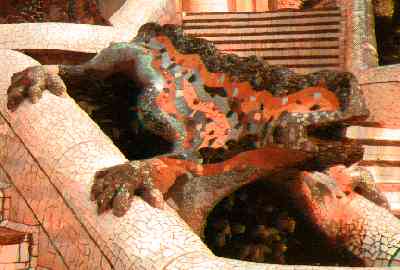 As we walk to Guell Park it
starts to rain but for a week in November the past four days of warm sunshine by far make
up for it. Guell bought a piece of hill to the North of expanding Barcelona to build an
estate of expensive houses on for the wealthy residents. He commissioned Gaudi to design
the surrounding parkland but only part of it was completed before the project failed. The
city council then bought the park for public use. The developed parts are at the south
side where the gates and gatehouses look like scenes from Hansel and Grettel. Two sets of
stairs lead up from there with a waterfall in between holding the lizzard that is now the
icon of the park. Everything is decorated with what looks like broken bathroom tiles.
Further up, 84 pillars hold up a plaza and create what was supposed to be a covered market
place. There are a couple of houses in the park, one of which Gaudi lived in for 20 years
and a number of curved, ornate bridges to carry some of the winding paths into what is now
only parkland but what was supposed to be residences. The top of the hill affords what
would be a good view of the city if not for the dull misty day. As we walk to Guell Park it
starts to rain but for a week in November the past four days of warm sunshine by far make
up for it. Guell bought a piece of hill to the North of expanding Barcelona to build an
estate of expensive houses on for the wealthy residents. He commissioned Gaudi to design
the surrounding parkland but only part of it was completed before the project failed. The
city council then bought the park for public use. The developed parts are at the south
side where the gates and gatehouses look like scenes from Hansel and Grettel. Two sets of
stairs lead up from there with a waterfall in between holding the lizzard that is now the
icon of the park. Everything is decorated with what looks like broken bathroom tiles.
Further up, 84 pillars hold up a plaza and create what was supposed to be a covered market
place. There are a couple of houses in the park, one of which Gaudi lived in for 20 years
and a number of curved, ornate bridges to carry some of the winding paths into what is now
only parkland but what was supposed to be residences. The top of the hill affords what
would be a good view of the city if not for the dull misty day. |
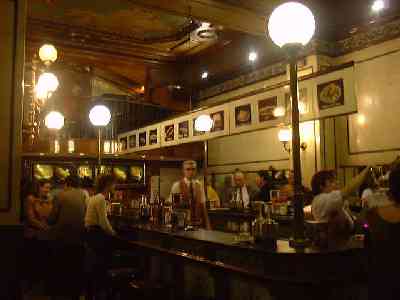 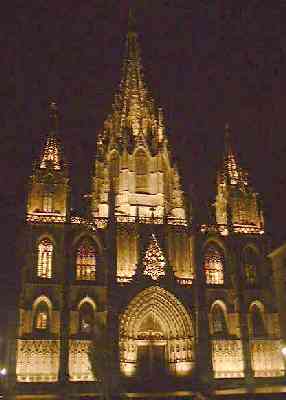 |
| As the sun sets we trek back down the hill to our accommodation for a well earned late siesta before dinner. We dine on tapas in a restaurant by the cathedral and drop in for a quick half-liter (it just don't sound the same as 'pint') in our favourite bar; Viena (with pianist). |
5/11/98. A walk in the woods. After a brief visit to the Roman tombs at Placa Vila de Madrid we take the metro as far north as it goes where we find that the tram is not running during the winter. The alternative bus driver dissuades us from going on saying that the funicular railway is also not running but we decide to walk instead. This turns into a 2 hour hike to the top of Tibidabo, at 542m, the highest hill around Barcelona. Further up the hill becomes pleasantly un-populated and covered with woods. The views out over Barcelona become fantastic although often shrouded in mist. The Temple del Sagrat Cor (another church), perched on the hilltop, pops into view occasionally as we walk along the windy path up round the hill. Right next to it the rides of a theme park seem strangely out of place. The church has some nice shrines to various saints but the best part was the glass display cases containing fairy lights in the shape of candles. These would light up if you inserted enough coins.
We made it to the Museu D'Art de Catalunya just before sun down which provided a good night-time view over the city. We were a bit late to visit any of the expositions so we trundled back to the hotel for a snooze before dinner (touristing can be hard work). |
6/11/98. Montserrat.
Breakfast from the supermarket again today, this time we ate it in the Placa de Catalunya basking in the morning sun. From there we negotiated the metro to the main-line station; Espanya, were we caught the 11:07 train (1770pts each) to Montserrat de Aeri. |
An hour later we were in the mountains at the foot of the cable car run to the monastery. The mountains look very much like the Olgas in central Australia and on closer inspection were also made of sedimentary rock looking like pebbles imbedded in concrete. The Funicular Aeria (cable car) runs steeply up the mountain side to the monastery near the top. |
The views were excellent of the hilly countryside with the sun picking out the red rock strata like contours on a map. At the top the air was very cool. The sunshine compensated for the cool until you moved out of it and then it got quite cold. |
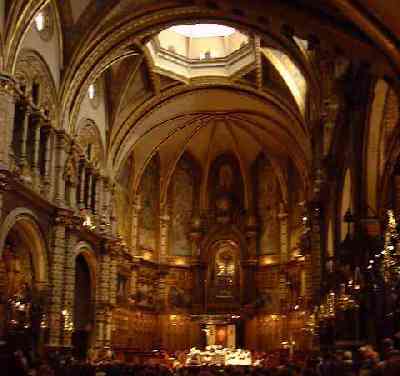 We checked out the monastery and listened to the boys choir before following a stream of people to see some of the shrines. The procession filed past a small statue of a woman holding a child. Everyone else kissed the hand of the woman (or the ball she was holding) in an unsanitary way. A small settlement had built up around the monastery including souvenir shops, cafes and even accommodation. Most of the new buildings were in a style totally out of keeping with the monastic ones but more closely resembling a French ski resort. |
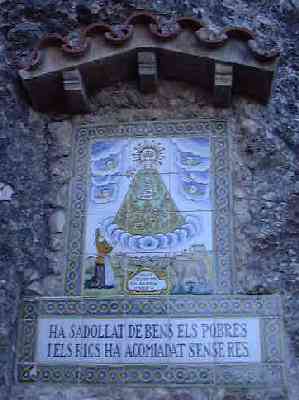 There were a number of walks around the mountain to visit various holy places and sacred statues. We chose 'The way of the Magnificat (streams)' but either the translation of Magnificat to Streams was incorrect or they had all dried up since. There were no magnificent cats either, just rather allot of strays. This seemed to be the case down in the city too where cats seem to have the run of the place. The walk just went past a whole heap of little shrines to little saints but the view out across the land was again quite magnificent. |
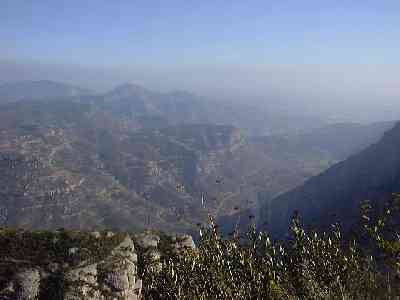 Despite the day being sunny and cloudless there seemed to be a hazy smog hanging in the air that gave the horizon a dirty look. I briefly wonder if it is an accumulation of cigarette and cigar smoke from the chuffing citizens in the city. Back at the settlement the shops and a stall furnish us with bread, cheese, ham and a small bottle of wine to sustain us before our journey back. There seems little to do here but stare at the view and take walks into the mountains but it is well worth it to get away from the city. The unusual rock formations are certainly worth a gander. The 2 hourly train service departs at 17:26 so we hop on the cable car which itself stops at 17:30 and start our journey back to Barcelona. Unfortunately we have the misfortune of sharing a carriage with an outing of screeching school kids. In a way it's nice to find out that they have their fair share of brats here too. Back at the hotel the same old buskers are playing the same old tunes outside our window. I seem to remember it being quite nice for the first few nights. Our last meal was paella and sangria at 'Meson Pirineos' restaurant then a bottle of Rioca at a rather lively little bar round the corner. |
7/11/98. Last day. Near the south end of the Rambla is a waxworks museum which seems to offer suitable last day entertainment. It was a pity to miss some of the sunshine but it turned out to be an excellent choice as the museum itself was a fine example of a wealthy residence being covered in marble and murals on the walls. The waxworks were very lifelike if sometimes not a good likeness to the original character. A last look at Port Vell before trying to find the Museo Erotica which proved to be permanently elusive. Just enough time left for a last super strong Spanish coffee.
The sun sets for us at Barcelona airport. 
Our 7 days in Barcelona cost us: Flights: £99 each from BA. LHR to Barcelona Hotel Lloret: Room; £244 for 7 nights Total cash spent: £305 (including food, drink, transport, entry fees etc) |